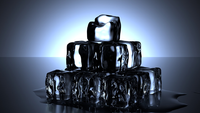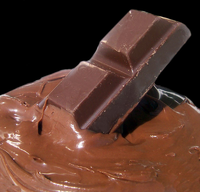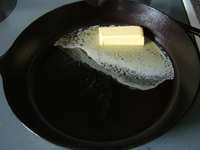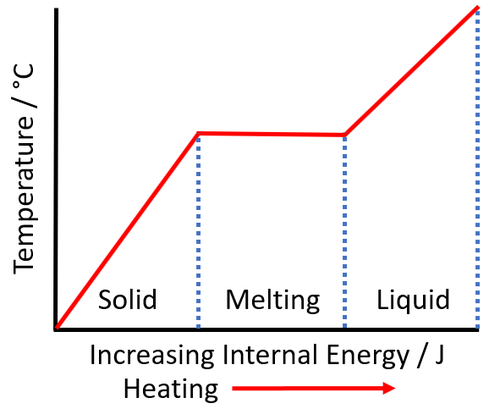Difference between revisions of "Melting"
(→Key Stage 3) |
|||
| (6 intermediate revisions by 2 users not shown) | |||
| Line 62: | Line 62: | ||
===About Melting=== | ===About Melting=== | ||
: [[Melting]] happens when the [[particle]]s in a [[solid]] break [[bond]]s holding them in fixed positions as they gain [[Potential Energy|potential energy]]. | : [[Melting]] happens when the [[particle]]s in a [[solid]] break [[bond]]s holding them in fixed positions as they gain [[Potential Energy|potential energy]]. | ||
| + | : The [[temperature]] at which a [[substance]] '''melts''' is called its [[Melting Point|melting point]]. | ||
| + | : [[Melting]] is an [[endothermic]] process, which means it needs to [[Absorb (Physics)|absorb]] [[energy]] to take place. | ||
| + | : [[Melting]] is a [[Physical Change|physical change]], which means it is [[Reversible Changes|reversible]] and does not produce new [[chemical]]s. | ||
{| class="wikitable" | {| class="wikitable" | ||
| − | |[[File:MeltingGraph.png|center| | + | |[[File:MeltingGraph.png|center|500px]] |
|- | |- | ||
| − | | style="height:20px; width: | + | | style="height:20px; width:500px; text-align:left;" |As a [[solid]] is [[heated]] the [[Internal Energy|internal energy]] increases. As the [[solid]] '''melts''' the [[temperature]] of the [[substance]] stays the same but the [[Potential Energy|potential energy]] of the [[particle]]s continues to increase. |
|} | |} | ||
| + | |||
| + | ===References=== | ||
| + | ====AQA==== | ||
| + | |||
| + | :[https://www.amazon.co.uk/gp/product/178294639X/ref=as_li_tl?ie=UTF8&camp=1634&creative=6738&creativeASIN=178294639X&linkCode=as2&tag=nrjc-21&linkId=51599bb45a2bfaf7c1b6a978b2ca2616 ''Melting, page 100, GCSE Combined Science Trilogy; Chemistry, CGP, AQA ''] | ||
| + | :[https://www.amazon.co.uk/gp/product/1782945962/ref=as_li_tl?ie=UTF8&camp=1634&creative=6738&creativeASIN=1782945962&linkCode=as2&tag=nrjc-21&linkId=476bb5c8d1dfb5c08ac81b6d4d1c98d8 ''Melting, page 102, GCSE Chemistry, CGP, AQA ''] | ||
| + | :[https://www.amazon.co.uk/gp/product/1782945571/ref=as_li_tl?ie=UTF8&camp=1634&creative=6738&creativeASIN=1782945571&linkCode=as2&tag=nrjc-21&linkId=9e29fad914244909903e5e93f8a01d179 ''Melting, page 37, GCSE Chemistry; The Revision Guide, CGP, AQA ''] | ||
| + | :[https://www.amazon.co.uk/gp/product/1471851370/ref=as_li_tl?ie=UTF8&camp=1634&creative=6738&creativeASIN=1471851370&linkCode=as2&tag=nrjc-21&linkId=01c69b0ae058f809cf636033e6ba793e ''Melting, page 72, GCSE Physics, Hodder, AQA ''] | ||
| + | :[https://www.amazon.co.uk/gp/product/1782946403/ref=as_li_tl?ie=UTF8&camp=1634&creative=6738&creativeASIN=1782946403&linkCode=as2&tag=nrjc-21&linkId=32a0abb60dff015b15b50e9b1d7b4644 ''Melting, pages 100, 101, GCSE Combined Science Trilogy; Physics, CGP, AQA ''] | ||
| + | :[https://www.amazon.co.uk/gp/product/1782945970/ref=as_li_tl?ie=UTF8&camp=1634&creative=6738&creativeASIN=1782945970&linkCode=as2&tag=nrjc-21&linkId=a120d24dcc7cc7a58192069a3aafc1d2 ''Melting, pages 110, 111, GCSE Physics; The Complete 9-1 Course for AQA, CGP, AQA ''] | ||
| + | :[https://www.amazon.co.uk/gp/product/1782945598/ref=as_li_tl?ie=UTF8&camp=1634&creative=6738&creativeASIN=1782945598&linkCode=as2&tag=nrjc-21&linkId=ad276ad49df77ab4b40ab4fd0fe10066 ''Melting, pages 122, 195 196, GCSE Combined Science; The Revision Guide, CGP, AQA ''] | ||
| + | :[https://www.amazon.co.uk/gp/product/1471851354/ref=as_li_tl?ie=UTF8&camp=1634&creative=6738&creativeASIN=1471851354&linkCode=as2&tag=nrjc-21&linkId=9012a0d354024419214fb3ad5ac44ba0 ''Melting, pages 324, 328, GCSE Combined Science Trilogy 1, Hodder, AQA ''] | ||
| + | :[https://www.amazon.co.uk/gp/product/178294558X/ref=as_li_tl?ie=UTF8&camp=1634&creative=6738&creativeASIN=178294558X&linkCode=as2&tag=nrjc-21&linkId=f0dfb66dafcb0c6e9449e7b1a4ae1ac310 ''Melting, pages 39, 40, GCSE Physics; The Revision Guide, CGP, AQA ''] | ||
| + | :[https://www.amazon.co.uk/gp/product/0008158770/ref=as_li_tl?ie=UTF8&camp=1634&creative=6738&creativeASIN=0008158770&linkCode=as2&tag=nrjc-21&linkId=ec31595e720e1529e49876c3866fff6e ''Melting, pages 88-9, 94-5, 103, GCSE Physics; Student Book, Collins, AQA ''] | ||
| + | :[https://www.amazon.co.uk/gp/product/1471851370/ref=as_li_tl?ie=UTF8&camp=1634&creative=6738&creativeASIN=1471851370&linkCode=as2&tag=nrjc-21&linkId=01c69b0ae058f809cf636033e6ba793e ''Melting; energy transfers, page 76, GCSE Physics, Hodder, AQA ''] | ||
| + | |||
| + | ====Edexcel==== | ||
| + | |||
| + | :[https://www.amazon.co.uk/gp/product/1782945725/ref=as_li_tl?ie=UTF8&camp=1634&creative=6738&creativeASIN=1782945725&linkCode=as2&tag=nrjc-21&linkId=694be7494de75af3349537d34e13f7f0 ''Melting, page 35, GCSE Chemistry; The Revision Guide, CGP, Edexcel ''] | ||
| + | :[https://www.amazon.co.uk/gp/product/1782948147/ref=as_li_tl?ie=UTF8&camp=1634&creative=6738&creativeASIN=1782948147&linkCode=as2&tag=nrjc-21&linkId=f63dcd8345f4e49c717b39a228a36c7c ''Melting, page 98, GCSE Chemistry, CGP, Edexcel ''] | ||
| + | :[https://www.amazon.co.uk/gp/product/1782945741/ref=as_li_tl?ie=UTF8&camp=1634&creative=6738&creativeASIN=1782945741&linkCode=as2&tag=nrjc-21&linkId=30da4f2178da182547b62a7329d13b57 ''Melting, page 98, GCSE Combined Science; The Revision Guide, CGP, Edexcel ''] | ||
| + | |||
| + | ====OCR==== | ||
| + | :[https://www.amazon.co.uk/gp/product/1782945679/ref=as_li_tl?ie=UTF8&camp=1634&creative=6738&creativeASIN=1782945679&linkCode=as2&tag=nrjc-21&linkId=a2db42f7b4bdf10cafaafa3bb9120940 ''Melting, page 12, Gateway GCSE Chemistry; The Revision Guide, CGP, OCR ''] | ||
| + | :[https://www.amazon.co.uk/gp/product/0198359829/ref=as_li_tl?ie=UTF8&camp=1634&creative=6738&creativeASIN=0198359829&linkCode=as2&tag=nrjc-21&linkId=90e8d7b4f039d53035238fa0320fe00b ''Melting, pages 76-77, Gateway GCSE Chemistry, Oxford, OCR ''] | ||
| + | :[https://www.amazon.co.uk/gp/product/1782945695/ref=as_li_tl?ie=UTF8&camp=1634&creative=6738&creativeASIN=1782945695&linkCode=as2&tag=nrjc-21&linkId=ceafcc80bcad6b6754ee97a0c7ceea53 ''Melting, pages 82, 152, 154, Gateway GCSE Combined Science; The Revision Guide, CGP, OCR ''] | ||
| + | :[https://www.amazon.co.uk/gp/product/0198359837/ref=as_li_tl?ie=UTF8&camp=1634&creative=6738&creativeASIN=0198359837&linkCode=as2&tag=nrjc-21&linkId=3c4229e8b023b2b60768e7ea2307cc6f ''Melting, specific latent heat of, pages 31, Gateway GCSE Physics, Oxford, OCR ''] | ||
Latest revision as of 10:19, 14 December 2019
Contents
Key Stage 2
Meaning
Melting is when a solid turns into a liquid.
- Verb: To melt
- Present Participle: Melting
| A solid will melt and become a liquid. |
About Melting
- Most solids can be melted to become a liquid.
- Melting is a reversible process. When a solid melts you can always freeze it back into a solid.
- You may have seen these solids melt
- Ice
- Wax
- Chocolate
- Butter
Examples
| Some ice cubes melt to make water. | Wax melts because of the flame. |
| Chocolate can melt in your mouth because your mouth is warm. | You can melt butter in a frying pan. |
Key Stage 3
Meaning
Melting is an endothermic process in which a solid turns into a liquid.
About Melting
- Most solids can be melted to become a liquid.
- Melting is a reversible process. When a solid melts you can always freeze it back into a solid.
- A solid can be melted by heating it.
| The particles in the solid vibrate faster until they vibrate fast enough that they break the bonds holding them in fixed positions. The particles become able to move past each other but are still touching which makes the state a liquid. |
Key Stage 4
Meaning
Melting is an endothermic physical change in which a solid turns into a liquid.
About Melting
- Melting happens when the particles in a solid break bonds holding them in fixed positions as they gain potential energy.
- The temperature at which a substance melts is called its melting point.
- Melting is an endothermic process, which means it needs to absorb energy to take place.
- Melting is a physical change, which means it is reversible and does not produce new chemicals.
| As a solid is heated the internal energy increases. As the solid melts the temperature of the substance stays the same but the potential energy of the particles continues to increase. |
References
AQA
- Melting, page 100, GCSE Combined Science Trilogy; Chemistry, CGP, AQA
- Melting, page 102, GCSE Chemistry, CGP, AQA
- Melting, page 37, GCSE Chemistry; The Revision Guide, CGP, AQA
- Melting, page 72, GCSE Physics, Hodder, AQA
- Melting, pages 100, 101, GCSE Combined Science Trilogy; Physics, CGP, AQA
- Melting, pages 110, 111, GCSE Physics; The Complete 9-1 Course for AQA, CGP, AQA
- Melting, pages 122, 195 196, GCSE Combined Science; The Revision Guide, CGP, AQA
- Melting, pages 324, 328, GCSE Combined Science Trilogy 1, Hodder, AQA
- Melting, pages 39, 40, GCSE Physics; The Revision Guide, CGP, AQA
- Melting, pages 88-9, 94-5, 103, GCSE Physics; Student Book, Collins, AQA
- Melting; energy transfers, page 76, GCSE Physics, Hodder, AQA
Edexcel
- Melting, page 35, GCSE Chemistry; The Revision Guide, CGP, Edexcel
- Melting, page 98, GCSE Chemistry, CGP, Edexcel
- Melting, page 98, GCSE Combined Science; The Revision Guide, CGP, Edexcel






